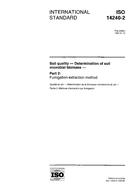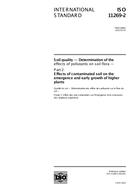-
-
Available Formats
- Options
- Availability
- Priced From ( in USD )
-
Available Formats
-
- Immediate download
- $166.00
- Add to Cart
-
- Printed Edition
- Ships in 1-2 business days
- $166.00
- Add to Cart
-
- Printed Edition + PDF
- Immediate download
- $259.00
- Add to Cart
Customers Who Bought This Also Bought
-

ISO 14240-2:1997
Priced From $81.00 -

ISO/TS 10832:2009
Priced From $166.00 -

ISO 11269-1:2012
Priced From $124.00 -

ISO 11269-2:2012
Priced From $166.00
About This Item
Full Description
ISO 16751:2020 specifies an extraction method to determine the bioavailable (potential and environmental available) fraction and the non-bioavailable fraction of a contaminant in soil using a "receiver phase" for an organic contaminant with strong sorbing or complexing properties, for example, Tenax°[1] or cyclodextrin, respectively.
NOTE 1 The bioavailable fraction is defined in ISO 17402 as environmental bioavailability.
The method is applicable for non-polar organic contaminants with an aqueous solubility of <100 mg/l. The method is applicable for soil and soil-like material including (dredged) sediments.
NOTE 2 The method is theoretically applicable to non-polar organic contaminants with an aqueous solubility of 1 000 mg/l. The method has been often applied for compounds with a much lower solubility (Kow > 3) and less for compounds with a higher solubility. The applicability is therefore defined for compounds with an aqueous solubility of <100 mg/l.
[1] Tenax° is an example of a suitable product available commercially. This information is given for the convenience of users of this document and does not constitute an endorsement by ISO of this product.
Document History
-
ISO 16751:2020
currently
viewing
Soil quality - Environmental availability of non-polar organic compounds - Determination of the potentially bioavailable fraction and the non-bioavailable fraction using a strong adsorbent or complexing agent- Most Recent
-
ISO/TS 16751:2018
Soil quality - Environmental availability of non-polar organic compounds - Determination of the potential bioavailable fraction and the non-bioavailable fraction using a strong adsorbent or complexing agent- Historical Version





